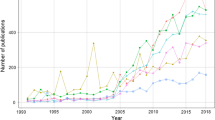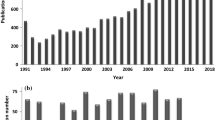Abstract
The increase of co-authored papers is a recognized fact. At the same time the factors influencing this change is not well known. This article aims at studying the patterns of EU science co-authorships. We analyzed articles published in 18 EU countries and their intra-EU (within EU) and extra-EU (with partners outside EU) co-publication pattern in five scientific fields. The results point to a Europeanisation of shared co-authorship rather than an internationalization outside Europe. Smaller countries co-authored more with other EU countries than bigger countries while the co-authorship rate with extra-EU partners was not dependent of the country’s size. The co-authorship patterns were also found to depend on the scientific field. Engineering and Computing & Technology was the field with the highest level of national publications and Physical, Chemical & Earth Sciences the field with the highest level of both intra-EU and extra-EU collaborations. These results support the view that a single market for research is developing within the EU with a seamless extension of national systems into other Member States ones.
Similar content being viewed by others
References
Adams, J. D., Black, G. C., Clemmons, J. R., Stephan, P. E. (2005), Scientific teams and institutional collaborations: Evidence from US universities, 1981–1999. Research Policy, 34: 259–285.
Andersson, A. E., Persson, O. (1993), Networking Scientists. Annals of Regional Science, 27: 11–21.
Archibugi, D., Coco, A. (2004), International partnerships for knowledge in business and academia-A comparison between Europe and the USA. Technovation, 24: 517–528.
Beaver, D. D. (2001), Reflections on scientific collaboration, (and its study): past, present, and future. Scientometrics, 52: 365–377.
Bozeman, B., Corley, E. (2004), Scientists’ collaboration strategies: implications for scientific and technical human capital. Research Policy, 33: 599–616.
Frame, J. D., Carpenter, M. P. (1979), International research collaboration. Social Studies of Science, 9: 481–497.
Georghiou, L. (1998), Global cooperation in research. Research Policy, 27: 611–626.
Glänzel, W. (2001), National characteristics in international scientific co-authorship relations. Scientometrics, 51: 69–115.
Glänzel, W., Schubert, A. (2001), Double effort = Double impact? A critical view at international co-authorship in chemistry. Scientometrics, 50: 199–214.
Gordon, M. D. (1980), A critical reassessment of inferred relations between multiple authorship, scientific collaboration, the production of papers and their acceptance for publication. Scientometrics, 2: 193–201.
Hagstrom, W. O. (1965), The Scientific Community, Basic Books, New York.
Katz, J. S. (1994), Geographical proximity and scientific collaboration. Scientometrics, 31: 31–43.
Katz, J. S., Martin, B. R. (1997), What is research collaboration? Research Policy, 26: 1–18.
Lewison, G., Cunningham, P. (1991), Bibliometric studies for the evaluation of trans-national research. Scientometrics, 21: 223–244.
Leydesdorff, L. (2000), Is the European Union becoming a single publication system?. Scientometrics, 47: 265–280.
Luukkonen, T., Persson, O., Sivertsen, G. (1992), Understanding patterns of international scientific collaboration. Science Technology & Human Values, 17: 101–126.
Luukkonen, T., Tijssen, R. J. W., Persson, O., Sivertsen, G. (1993), The measurement of international scientific collaboration. Scientometrics, 28: 15–36.
Melin, G. (1999), Impact of national size on research collaboration — A comparison between Northern EU and American universities. Scientometrics, 46: 161–170.
Melin, G., Persson, O. (1996), Studying research collaboration using co-authorships. Scientometrics, 36: 363–377.
Narin, F., Stevens, K., Whitlow, E. S. (1991), Scientific cooperation in Europe and the citation of multinationally authored papers. Scientometrics, 21: 313–323.
Persson, O., Glänzel, W., Danell, R. (2004), Inflationary bibliometric values: The role of scientific collaboration and the need for relative indicators in evaluative studies. Scientometrics, 60: 421–432.
Price, D. J. D. (1963), Little Science, Big Science, Columbia University Press, New York.
Rigby, J., Edler, J. (2005), Peering inside research networks: Some observations on the effect of the intensity of collaboration on the variability of research quality. Research Policy, 34: 784–794.
Schott, T. (1993), World science-globalization of institutions and participation. Science Technology & Human Values, 18: 196–208.
Schubert, A., Braun, T. (1990), International collaboration in the sciences, 1981-1985. Scientometrics, 19: 3–10.
Smith, M. (1958), The trend toward multiple authorship in psychology. American Psychologist, 13: 596–599.
Wagner, C. S. (2005), Six case studies of international collaboration in science. Scientometrics, 62: 3–26.
Zitt, M., Bassecoulard, E., Okubo, Y. (2000), Shadows of the past in international cooperation: Collaboration profiles of the top five producers of science. Scientometrics, 47: 627–657.
Author information
Authors and Affiliations
Corresponding author
Rights and permissions
About this article
Cite this article
Mattsson, P., Laget, P., Nilsson, A. et al. Intra-EU vs. extra-EU scientific co-publication patterns in EU. Scientometrics 75, 555–574 (2008). https://doi.org/10.1007/s11192-007-1793-x
Received:
Published:
Issue Date:
DOI: https://doi.org/10.1007/s11192-007-1793-x




